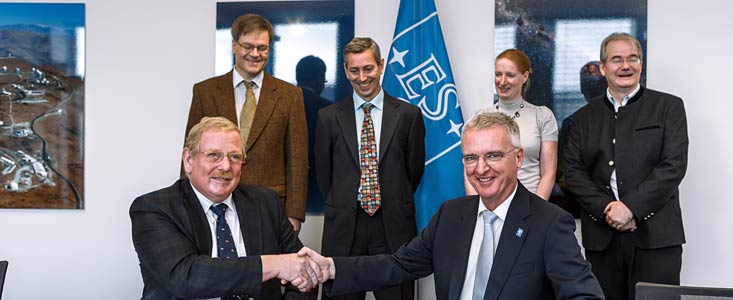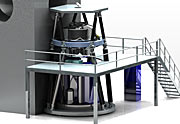Mededeling
Agreement Signed for MICADO Camera for E-ELT
18 september 2015
ESO has signed an agreement with a consortium of institutes across Europe [1], to design and construct the MICADO camera (Multi-AO Imaging Camera for Deep Observations), one of the first-light instruments for the European Extremely Large Telescope (E-ELT). MICADO will be the first dedicated imaging camera for the giant telescope and will take the power of adaptive optics to the next level.
The agreement was signed by Reinhard Genzel, Director of the Max-Planck-Institut für extraterrestrische Physik, representing the consortium, and Tim de Zeeuw, Director General of ESO, at a ceremony at ESO Headquarters on 18 September 2015. The Principal Investigator of MICADO, Richard Davies, was also present.
MICADO will equip the E-ELT with a first-light capability for diffraction-limited imaging at near-infrared wavelengths. The design of MICADO was driven by a desire for high sensitivity and resolution, astrometric accuracy, and wide wavelength coverage spectroscopy.
The MICADO design has been optimised for use with the MAORY (Multi-conjugate Adaptive Optics RelaY) system, a new laser guide star adaptive optics module for the E-ELT, but it can also work in other adaptive optics modes.
MICADO will allow the full resolution potential of the giant telescope to be brought to bear on many current areas of research. These include imaging the detailed structure of galaxies at high redshift, the study of individual stars in nearby galaxies, and, using its coronographic mode, the discovery and characterisation of exoplanets. MICADO will also be a uniquely powerful tool for exploring environments where gravitational forces are extremely strong, such as close to the supermassive black hole at the centre of our galaxy, the Milky Way.
In addition to its primary imaging role, MICADO also includes a single-slit spectrograph that is ideal for obtaining spectra of compact objects. This mode will target many areas of astronomy, such as measuring the masses of the central black holes of nearby galaxies from the velocities of their stars, and observing high-redshift galaxies to calculate their ages, chemical makeup and histories. The instrument will also obtain spectra of supernovae produced by the first generation of massive stars in the Universe.
MICADO is the culmination of extensive earlier development work, both at ESO and in the community, over many years. In particular early instrument studies were initiated by Sandro D'Odorico at ESO.
Notes
[1] The MICADO consortium comprises: MPE: Max-Planck-Institut für extraterrestrische Physik (Germany); MPIA: Max-Planck-Institut für Astronomie (Germany); USM: Universitäts-Sternwarte München (Germany); IAG: Georg-August-Universität Göttingen/Georg-August-Universität; Göttingen Stiftung Öffentlichen Rechts (Executing institute: Institute for Astrophysics) (Germany); NOVA: Netherlands Research School for Astronomy (Nederlandse Onderzoekschool voor de Astronomie) (The Netherlands); CNRS/INSU: Centre National de la Recherche Scientifique/Institut National des Sciences de l’Univers (representing LESIA, GEPI and IPAG) (France); A*: An Austrian partnership collectively represented by the University of Vienna (The A* partnership comprises the University of Vienna, the University of Innsbruck, the University Graz, the University of Linz and RICAM Linz [Austrian Academy of Sciences]. Contributions to MICADO come from Vienna, Innsbruck, Graz and Linz.) (Austria), and INAF-OAPD: National Institute for Astrophysics at the Observatory of Padova (Italy).
Links
- MICADO webpage at ESO.
- MICADO: the E-ELT Adaptive Optics Imaging Camera (Davies et al., 2010)
- MICADO (Max-Planck-Institut für extraterrestrische Physik)
- MICADO at Universität Göttingen
- MPE press release on MICADO kick-off (English) (German)
Contact
Ric Davies
MICADO Principal Investigator
Max-Planck-Institut für extraterrestrische Physik
Garching bei München, Germany
Tel: +49 89 30000 3298
E-mail: davies@mpe.mpg.de
Hannelore Haemmerle
MPE Press Officer
Max-Planck-Institut für extraterrestrische Physik
Garching bei München, Germany
E-mail: hanneh@mpe.mpg.de
Suzanne Ramsay
ESO Project Scientist
Garching bei München, Germany
Tel: +49 89 3200 6665
Email: sramsay@eso.org
Richard Hook
ESO Public Information Officer
Garching bei München, Germany
Tel: +49 89 3200 6655
Cell: +49 151 1537 3591
Email: rhook@eso.org
Over de Mededeling
| Id: | ann15068 |
Our use of Cookies
We use cookies that are essential for accessing our websites and using our services. We also use cookies to analyse, measure and improve our websites’ performance, to enable content sharing via social media and to display media content hosted on third-party platforms.
ESO Cookies Policy
The European Organisation for Astronomical Research in the Southern Hemisphere (ESO) is the pre-eminent intergovernmental science and technology organisation in astronomy. It carries out an ambitious programme focused on the design, construction and operation of powerful ground-based observing facilities for astronomy.
This Cookies Policy is intended to provide clarity by outlining the cookies used on the ESO public websites, their functions, the options you have for controlling them, and the ways you can contact us for additional details.
What are cookies?
Cookies are small pieces of data stored on your device by websites you visit. They serve various purposes, such as remembering login credentials and preferences and enhance your browsing experience.
Categories of cookies we use
Essential cookies (always active): These cookies are strictly necessary for the proper functioning of our website. Without these cookies, the website cannot operate correctly, and certain services, such as logging in or accessing secure areas, may not be available; because they are essential for the website’s operation, they cannot be disabled.
Functional Cookies: These cookies enhance your browsing experience by enabling additional features and personalization, such as remembering your preferences and settings. While not strictly necessary for the website to function, they improve usability and convenience; these cookies are only placed if you provide your consent.
Analytics cookies: These cookies collect information about how visitors interact with our website, such as which pages are visited most often and how users navigate the site. This data helps us improve website performance, optimize content, and enhance the user experience; these cookies are only placed if you provide your consent. We use the following analytics cookies.
Matomo Cookies:
This website uses Matomo (formerly Piwik), an open source software which enables the statistical analysis of website visits. Matomo uses cookies (text files) which are saved on your computer and which allow us to analyze how you use our website. The website user information generated by the cookies will only be saved on the servers of our IT Department. We use this information to analyze www.eso.org visits and to prepare reports on website activities. These data will not be disclosed to third parties.
On behalf of ESO, Matomo will use this information for the purpose of evaluating your use of the website, compiling reports on website activity and providing other services relating to website activity and internet usage.
Matomo cookies settings:
Additional Third-party cookies on ESO websites: some of our pages display content from external providers, e.g. YouTube.
Such third-party services are outside of ESO control and may, at any time, change their terms of service, use of cookies, etc.
YouTube: Some videos on the ESO website are embedded from ESO’s official YouTube channel. We have enabled YouTube’s privacy-enhanced mode, meaning that no cookies are set unless the user actively clicks on the video to play it. Additionally, in this mode, YouTube does not store any personally identifiable cookie data for embedded video playbacks. For more details, please refer to YouTube’s embedding videos information page.
Cookies can also be classified based on the following elements.
Regarding the domain, there are:
- First-party cookies, set by the website you are currently visiting. They are stored by the same domain that you are browsing and are used to enhance your experience on that site;
- Third-party cookies, set by a domain other than the one you are currently visiting.
As for their duration, cookies can be:
- Browser-session cookies, which are deleted when the user closes the browser;
- Stored cookies, which stay on the user's device for a predetermined period of time.
How to manage cookies
Cookie settings: You can modify your cookie choices for the ESO webpages at any time by clicking on the link Cookie settings at the bottom of any page.
In your browser: If you wish to delete cookies or instruct your browser to delete or block cookies by default, please visit the help pages of your browser:
Please be aware that if you delete or decline cookies, certain functionalities of our website may be not be available and your browsing experience may be affected.
You can set most browsers to prevent any cookies being placed on your device, but you may then have to manually adjust some preferences every time you visit a site/page. And some services and functionalities may not work properly at all (e.g. profile logging-in, shop check out).
Updates to the ESO Cookies Policy
The ESO Cookies Policy may be subject to future updates, which will be made available on this page.
Additional information
For any queries related to cookies, please contact: pdprATesoDOTorg.
As ESO public webpages are managed by our Department of Communication, your questions will be dealt with the support of the said Department.





